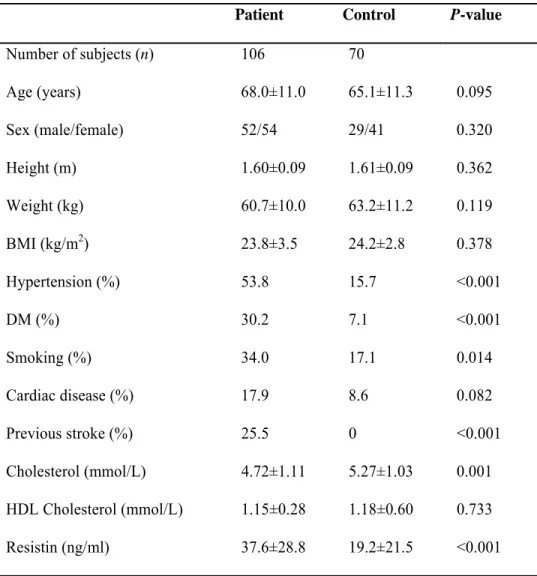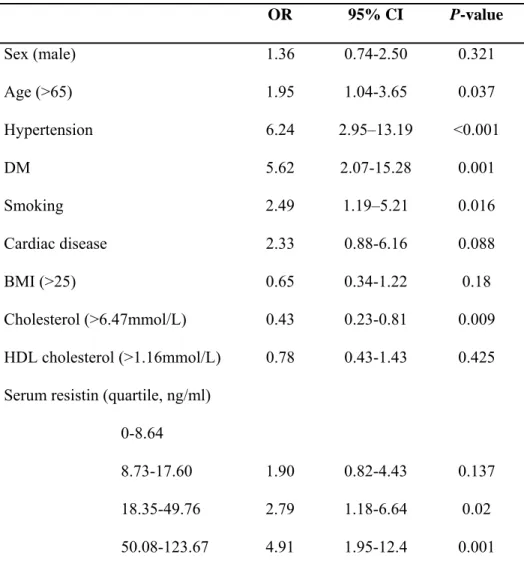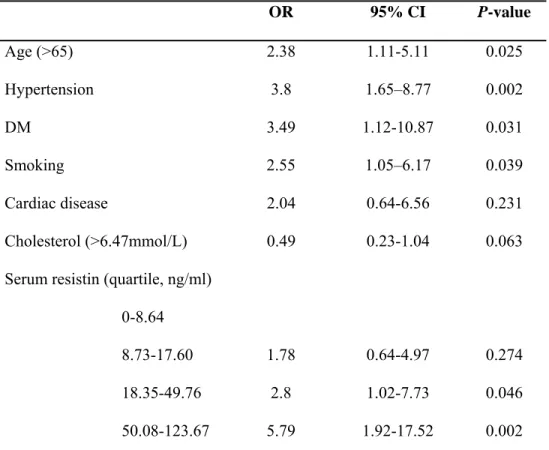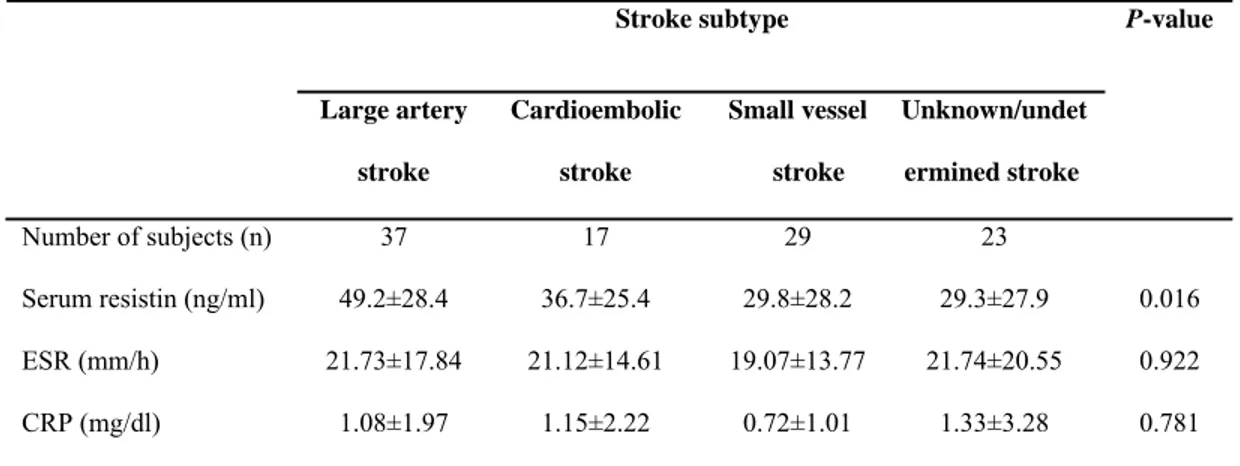Influence of serum resistin on acute
cerebral infarction
Kee Ook Lee
Department of Medicine
Influence of serum resistin on acute
cerebral infarction
Directed by Professor Ji Hoe Heo
The Master's Thesis
submitted to the Department of Medicine
the Graduate School of Yonsei University
in partial fulfillment of the requirements for the degree
of Master of Medical Science
Kee Ook Lee
This certifies that the Master's Thesis of
Kee Ook Lee is approved.
---
Thesis Supervisor: Ji Hoe Heo
---
Kyung-Yul Lee
---
Jong Eun Lee
The Graduate School
Yonsei University
ACKNOWLEDGMENTS
I would like to express my gratitude to all those who gave me the opportunity to complete this thesis.
I am deeply indebted to my supervisor Prof. Dr. Ji Hoe Heo from department of neurology whose advice, stimulating suggestions and encouragement helped me in studying and writing this thesis all the time. Also, I would like to say that, his passion and efforts for training me in the academic and clinical field have been very impressive and honorable.
I am very grateful to advisers, Prof. Dr. Kyung-Yul Lee from department of neurology and Prof. Jong Eun Lee from department of anatomy for their professional advice and experience shared with me.
Especially, I would like to give my special thanks to my son, my wife and also my parents whose love enabled me to complete this work.
<TABLE OF CONTENTS>
ABSTRACT··· 1
I. INTRODUCTION ··· 3
II. MATERIALS AND METHODS··· 4
1. Patient selection ··· 4
2. Definition and diagnosis of acute cerebral infarction··· 5
3. Control group selection ··· 6
4. Data collection and laboratory examinations ··· 6
5. Statistical analysis ··· 7
III. RESULTS ··· 7
1. Subject demographics and clinical characteristics ··· 7
2. Univariate analysis of risk factors ···10
3. Logistic regression analysis ···12
4. Relation between serum resistin and stroke etiology ···14
5. Relation between serum resistin and stroke severity···16
IV. DISCUSSION ···16
V. CONCLUSION ···18
REFERENCES ···19
ABSTRACT (IN KOREAN) ···23
LIST OF TABLES
Table 1. Subject demographics and clinical characteristics ··· 9
Table 2. Univariate analysis of risk factors for cerebral ischemic
events··· 11
Table 3. Adjusted relative odds ratios of cerebral ischemic
events related with various risk factors··· 13
Table 4. Relation between serum resistin and stroke etiology 15
ABSTRACT
Influence of serum resistin on acute cerebral infarction Kee Ook Lee
Department of Medicine
The Graduate School, Yonsei University
(Directed by Professor Ji Hoe Heo)
Background
Human resistin, which is a member of small cysteine-rich secreted proteins, has been implicated in inflammatory responses in several inflammatory conditions, such as acute pancreatitis, ankylosing spondylitis, Kawasaki disease and atherosclerosis. However, the relation between the serum resistin level and ischemic stroke has not been clearly elucidated. The aim of this study is to assess the clinical role of serum resistin in patients with acute cerebral infarction.
Methods
A total of 106 patients with acute cerebral infarction and 70 age-matched healthy control subjects were included in this prospective study. Serum resistin levels were determined by enzyme-linked immunosorbent sandwich assay in the patient and control group.
Results
The serum resistin level was significantly higher in the patient group (37.6 ± 28.8 ng/ml) compared with the control group (19.2 ± 21.5; P <0.001). We also
found that, as the quartile level of serum resistin increased, each adjusted relative odds ratio (OR) for stroke event increased. The highest quartile level of serum resistin was significantly associated with the increased risk of acute cerebral infarction (OR=5.79; P = 0.002). When we assessed the relation between serum resistin and stroke subtypes classified as per the Trial of ORG 10172 in Acute Stroke Treatment Classification, the serum resistin level in the large artery atherscelrosis subtype increased significantly (49.2 ± 28.4 ng/ml;
P = 0.016). Conclusion
This study provides a more specific additional evidence of relation between the high serum resistin concentration and acute cerebral infarction, especially in the large artery atherosclerosis subtype. Further large-scale prospective studies are required to confirm the role of serum resistin in acute cerebral infarction.
---
Key words: serum resistin, acute cerebral infarction, stroke subtype
Influence of serum resistin on acute cerebral infarction Kee Ook Lee
Department of Medicine
The Graduate School, Yonsei University
(Directed by Professor Ji Hoe Heo)
I. INTRODUCTION
Ischemic stroke is a leading cause of severe disability and death.1 In the majority of cases, stroke is believed to be a multifactorial disorder. Although different mechanisms are involved in the pathogenesis of stroke, increasing evidences show that inflammation is implicated in several aspects of acute ischemic stroke.2 Inflammatory processes are involved in the pathogenesis of atherosclerosis and brain tissue injury following cerebral ischemia.3,4
Ischemic stroke begins with transient or permanent reduction in cerebral blood flow, which leads to energy failure, excitotoxicity and oxidative damage. As the result of these damages, secondary deleterious phenomena, such as microvascular injury, blood brain barrier dysfunction and inflammatory responses, occur, which may exacerbate the initial injury and can lead to permanent cerebral damage.5
C-reactive protein (CRP), interleukin 6, and fibrinogen may be associated with myocardial infarction, stroke, cardiovascular death, and peripheral arterial disease.6-9
Resistin is a 114-amino acid polypeptide (12.5 kDa) hormone that belongs to a new gene family of small cysteine-rich secreted proteins.10 Resistin is abundantly expressed in monocytes and macrophages in human, and promotes endothelial cell activation and smooth muscle cell proliferation.11-13 Serum resistin levels had a positive relation with plasma inflammatory biomarkers, such as interleukin (IL)-6, soluble tumor necrosis factor (TNF)-α receptor 2, or adhesion molecules.14,15 These facts suggested that resistin may have a potential role in the pathogenesis of atherosclerosis.
The aim of the present study is to investigate the relation between the serum resistin level and acute cerebral infarction, taking various subtypes of cerebral infarction into account .
II. MATERIALS AND METHODS 1. Patient selection
The study group consisted of patients with acute cerebral infarction who had been admitted to the department of neurology, Konyang University Hospital, Daejeon, Korea from July, 2008 to Dec, 2010. All patients were examined by brain magnetic resonance imaging (MRI), including T2-weighted and diffusion-weighted sequences. We assessed the previous stroke history, cardiac diseases
(such as atrial fibrillation, myocardial infarction, and valvular heart disease), diabetes mellitus, hypertension, and smoking in all subjects. Serum total cholesterol, high-density lipoprotein cholesterol, and body mass index were also determined.
Exclusion criteria were severe hepatic dysfunctions (alanine aminotransferase or aspartate aminotransferase > 2 times as high as the upper limit of normal value) or renal dysfunction (serum creatinine > 1.6 mg/dL), recent infection history, malignancy, and previous history of neurologic disorders including peripheral vascular occlusive disease, autoimmune disease, or any other neurologic disorders.
2. Definition and diagnosis of acute cerebral infarction
Acute cerebral infarction was diagnosed on the basis of clinical symptoms and imaging evidence of computed tomography or MRI, and only confirmed cases were considered for analysis. The severity of neurologic deficits and the functional status of patients were assessed using the National Institutes of Health Stroke Scale (NIHSS) and the modified Rankin Scale (mRS) by a certified vascular neurologist.16,17 With all available clinical, laboratory and neuroimaging data, etiologic subtypes were determined according to the Trial of ORG 10172 in Acute Stroke Treatment (TOAST) criteria.18
3. Control group selection
The control group consisted of 70 patients whose primary symptoms were headache and dizziness, without any recent stroke history or any other thrombotic events.
This study was approved by the human research ethical committee at College of Medicine, Konyang University, Daejeon, Korea. Informed consent was obtained from all subjects.
4. Data collection and laboratory examinations
All blood samples were obtained before initiating treatment (with an anticoagulant and/or an antiplatelet agent). Serum specimens were centrifuged and frozen within 2 hours of collection and stored at –80ºC until they were analyzed. Serum resistin levels were measured by the enzyme-linked immunosorbent sandwich assay (ELISA) kit commercially available (Invitrogen, Camarillo, CA, USA), which employed an affinity-purified polyclonal anti-human resistin antibody for coating and the same antibody was coupled to horseradish peroxidase for detection, according to the manufacturer's instructions. The lower detection limit of this assay was 100 pg/ml. Tests were performed in one laboratory by a single operator. The serum erythrocyte sedimentation rates (ESR), CRP, total cholesterol and high density lipoprotein (HDL) cholesterol were measured by conventional methods in our hospital laboratory.
5. Statistical analysis
We divided the subjects into quartiles according to their respective resistin level as follows: < 8.64, 8.73 to 17.60, 18.35 to 49.76 and ≥ 50.08 ng/ml. The role of serum resistin in stroke was assessed by comparing the control group with the patient group. Logistic regression analysis was used to determine the relation between risk factors and acute cerebral infarction. After univariate analyses, odds ratio (OR) with 95% confidence interval (CI) were calculated using multivariate logistic regression. In addition, we assessed the relation between the stroke subtype and the serum resistin level using one-way analysis of variance (ANOVA). Student’s t-test was used to compare continuous variables between the patient group and the control group. Chi-square and Fisher’s exact tests were used to compare categorical variables. Continuous variables were expressed as mean ± standard deviation (SD), and categorical variables were expressed as numbers and percentages. Statistical analysis was performed using SPSS version 12.0 (Chicago, IL, USA). P < 0.05 was considered significant.
III. RESULTS
1. Subject demographics and clinical characteristics
The clinical characteristics, demographics and laboratory findings for the participants are shown in Table 1. When compared with the control group,
hypertension, diabetes mellitus, smoking and previous stroke were more common in the patient group. Besides, the serum resistin level was also higher in the patient group (37.6 ± 28.8 ng/ml) than the control group (19.2 ± 21.5 ng/ml; P <0.001).
Table 1. Subject demographics and clinical characteristics.
Patient Control P-value Number of subjects (n) 106 70 Age (years) 68.0±11.0 65.1±11.3 0.095 Sex (male/female) 52/54 29/41 0.320 Height (m) 1.60±0.09 1.61±0.09 0.362 Weight (kg) 60.7±10.0 63.2±11.2 0.119 BMI (kg/m2) 23.8±3.5 24.2±2.8 0.378 Hypertension (%) 53.8 15.7 <0.001 DM (%) 30.2 7.1 <0.001 Smoking (%) 34.0 17.1 0.014 Cardiac disease (%) 17.9 8.6 0.082 Previous stroke (%) 25.5 0 <0.001 Cholesterol (mmol/L) 4.72±1.11 5.27±1.03 0.001 HDL Cholesterol (mmol/L) 1.15±0.28 1.18±0.60 0.733 Resistin (ng/ml) 37.6±28.8 19.2±21.5 <0.001 Data are expressed as mean ± SD. BMI, body mass index; DM, diabetes mellitus; HDL, high-density lipoprotein; Cardiac disease includes atrial fibrillation, myocardial infarction, and valvular heart disease.
2. Univariate analysis of risk factors
Univariate analysis showed that older age (> 65 years old), hypertension, diabetes mellitus, smoking, cardiac disease, total cholesterol and serum resistin level were significantly related with cerebral infarction (Table 2).
Table 2. Univariate analysis of risk factors for cerebral ischemic events. OR 95% CI P-value Sex (male) 1.36 0.74-2.50 0.321 Age (>65) 1.95 1.04-3.65 0.037 Hypertension 6.24 2.95–13.19 <0.001 DM 5.62 2.07-15.28 0.001 Smoking 2.49 1.19–5.21 0.016 Cardiac disease 2.33 0.88-6.16 0.088 BMI (>25) 0.65 0.34-1.22 0.18 Cholesterol (>6.47mmol/L) 0.43 0.23-0.81 0.009 HDL cholesterol (>1.16mmol/L) 0.78 0.43-1.43 0.425 Serum resistin (quartile, ng/ml)
0-8.64
8.73-17.60 1.90 0.82-4.43 0.137
18.35-49.76 2.79 1.18-6.64 0.02 50.08-123.67 4.91 1.95-12.4 0.001 CI, confidence interval; OR, odds ratio; DM, diabetes mellitus; BMI, body mass index; HDL, high-density lipoprotein; Cardiac disease includes atrial fibrillation, myocardial infarction, and valvular heart disease.
3. Logistic regression analysis
We have examined the possible interaction between the serum resistin level and stroke risk factors. Statistically, no significant first order interaction was observed between the resistin level and stroke risk factors. When we analyzed risk factors for acute cerebral infarction, we found that, as the quartile level of serum resistin increased, each adjusted relative OR also increased. The highest quartile of the serum resistin level was related with the significantly increased risk of acute cerebral infarction. Adjusted OR of the highest quartile of serum resistin was 5.79 for stroke event (95% CI, 1.92–17.52; P = 0.002), which was higher than adjusted ORs of other conventional risk factors for stroke (Table 3).
Table 3. Adjusted relative odds ratios of cerebral infarction related with various risk factors.
OR 95% CI P-value Age (>65) 2.38 1.11-5.11 0.025 Hypertension 3.8 1.65–8.77 0.002 DM 3.49 1.12-10.87 0.031 Smoking 2.55 1.05–6.17 0.039 Cardiac disease 2.04 0.64-6.56 0.231 Cholesterol (>6.47mmol/L) 0.49 0.23-1.04 0.063 Serum resistin (quartile, ng/ml)
0-8.64
8.73-17.60 1.78 0.64-4.97 0.274
18.35-49.76 2.8 1.02-7.73 0.046 50.08-123.67 5.79 1.92-17.52 0.002 CI, confidence interval; OR, odds ratio; DM, diabetes mellitus; Cardiac disease includes atrial fibrillation, myocardial infarction, and valvular heart disease.
4. Relation between serum resistin and stroke etiology
When we assessed the relation between the serum resistin level and stroke subtypes on the basis of the TOAST classification, significant differences were observed among the stroke subtypes (P = 0.016). The serum resistin level was highest in the subtype of large artery atherosclerosis, followed by cardioembolism and small vessel occlusion and unknown/undetermined stroke (Table 4). No statistically significant difference in other inflammatory markers (ESR, CRP) was found among the four subtypes (Table 4).
Table 4. Relationship between serum resistin level and stroke subtypes Stroke subtype Large artery stroke Cardioembolic stroke Small vessel stroke Unknown/undet ermined stroke P-value Number of subjects (n) 37 17 29 23 Serum resistin (ng/ml) 49.2±28.4 36.7±25.4 29.8±28.2 29.3±27.9 0.016 ESR (mm/h) 21.73±17.84 21.12±14.61 19.07±13.77 21.74±20.55 0.922 CRP (mg/dl) 1.08±1.97 1.15±2.22 0.72±1.01 1.33±3.28 0.781
Data are expressed as mean ± SD. ESR, erythrocyte sedimentation rates; CRP, C-reactive protein.
5. Relation between serum resistin and stroke severity
Although CRP increased with quartiles of resistin, it was not statistically significant (P = 0.093). There was a trend towards higher level of serum resistin in patients with more severe neurologic deficits (as demonstrated by higher NIHSS score), however it was not significant (r = 0.17, P = 0.081).
IV. DISCUSSION
In our study, serum resistin levels increased in patients with acute ischemic stroke. Initially, resistin was thought to be a signaling protein to provide a relation between obesity and insulin resistance.19 However, in humans, it has been suggested that there is no relation between resistin and obesity or insulin resistance, and that resistin is more related with subclinical inflammation than insulin resistance.20,21 Recently, resistin was shown to contribute to development of atherosclerosis.11-13 Resistin induced monocyte-endothelial cell adhesion by increasing intercellular adhesion molecule-1 (ICAM-1) and vascular cell adhesion molecule-1 (VCAM-1) expression in endothelial cells.22,23 Another study showed that resistin promoted lipid accumulation in human macrophages by upregulating CD36 cell surface expression and might act as a modulator for macrophage to foam cell transformation.24 However, the relation between serum resistin levels and ischemic stroke has not been clearly elucidated. Previous studies showed a controversial evidence of serum resistin in acute cerebral
ischemic events.25-27 In a Hisayama study, the elevated serum resistin concentration was a risk factor for ischemic stroke, especially lacunar and atherothrombotic stroke in the general Japanese population.27 In contrast, a 42-month prospective study of Korean patients with type 2 diabetes showed that resistin levels had no influence on the risk of cardiovascular diseases including stroke.25 In another study, high plasma resistin levels were related with an increased risk of myocardial infarction but not with a risk of ischemic stroke.26 In the present study, we found that high serum resistin levels may be a factor related with the risk of ischemic stroke. Regarding stroke subtypes, our study demonstrated that serum resistin seemed to be related to large artery stroke. Inflammation is a major factor for development of atherosclerosis.4 Thus, these relations between inflammation and atherosclerosis may reasonably explain the mechanism of the high serum resistin level as a related factor to large artery stroke.
Notably, in our study, there was a trend towards higher serum resistin levels as the more severe neurologic deficit although it was not statistically significant. The higher serum resistin level in the more severe stroke may be explained by the higher resistin level in large artery atherosclerosis. Usually, large artery atherosclerosis produces multiple and large ischemic lesions which may cause more severe stroke.28
This study has several limitations. First, all subjects were Koreans, which may restrict application of the study results to Korean patients. Second, all blood
sampling for serum resistin measurements was performed during the acute stage of a cerebral ischemic event. We did not measure the serum resistin level during the stable period after cerebral infarction. Therefore, it is not clear whether the high serum resisitn level is a risk factor or a consequence of acute cerebral infarction. To resolve this question, serial measurements of the serum resitin level would be helpful. Third, our study had a small sample size.
V. CONCLUSION
The present findings provides a more specific additional evidence of relation between the high serum resistin level and acute cerebral ischemia, especially in the large artery atherosclerosis subtype.
REFERENCES
1. World Health Organization. World Health Report 2002. Geneva, Switzerland: World Health Organization; 2002.
2. Muir KW, Tyrrell P, Sattar N, Warburton E. Inflammation and ischaemic stroke. Curr Opin Neurol 2007;20:334-42.
3. Rost NS, Wolf PA, Kase CS, Kelly-Hayes M, Silbershatz H, Massaro JM, et al. Plasma concentration of C-reactive protein and risk of ischemic stroke and transient ischemic attack: the Framingham study. Stroke 2001;32:2575-9.
4. Ross R. Atherosclerosis--an inflammatory disease. N Engl J Med 1999;340:115-26.
5. Dirnagl U, Iadecola C, Moskowitz MA. Pathobiology of ischaemic stroke: an integrated view. Trends Neurosci 1999;22:391-7.
6. Ridker PM, Rifai N, Stampfer MJ, Hennekens CH. Plasma concentration of interleukin-6 and the risk of future myocardial infarction among apparently healthy men. Circulation 2000;101:1767-72.
7. Ridker PM, Stampfer MJ, Rifai N. Novel risk factors for systemic atherosclerosis: a comparison of C-reactive protein, fibrinogen, homocysteine, lipoprotein(a), and standard cholesterol screening as predictors of peripheral arterial disease. JAMA 2001;285:2481-5.
8. Cao JJ, Thach C, Manolio TA, Psaty BM, Kuller LH, Chaves PH, et al. C-reactive protein, carotid intima-media thickness, and incidence of ischemic
stroke in the elderly: the Cardiovascular Health Study. Circulation 2003;108:166-70.
9. Ridker PM. Clinical application of C-reactive protein for cardiovascular disease detection and prevention. Circulation 2003;107:363-9.
10. Steppan CM, Lazar MA. The current biology of resistin. J Intern Med 2004;255:439-47.
11. Verma S, Li SH, Wang CH, Fedak PW, Li RK, Weisel RD, et al. Resistin promotes endothelial cell activation: further evidence of adipokine-endothelial interaction. Circulation 2003;108:736-40.
12. Calabro P, Samudio I, Willerson JT, Yeh ET. Resistin promotes smooth muscle cell proliferation through activation of extracellular signal-regulated kinase 1/2 and phosphatidylinositol 3-kinase pathways. Circulation 2004;110:3335-40.
13. Reilly MP, Lehrke M, Wolfe ML, Rohatgi A, Lazar MA, Rader DJ. Resistin is an inflammatory marker of atherosclerosis in humans. Circulation 2005;111:932-9.
14. Jung HS, Park KH, Cho YM, Chung SS, Cho HJ, Cho SY, et al. Resistin is secreted from macrophages in atheromas and promotes atherosclerosis. Cardiovasc Res 2006;69:76-85.
15. Lehrke M, Reilly MP, Millington SC, Iqbal N, Rader DJ, Lazar MA. An inflammatory cascade leading to hyperresistinemia in humans. PLoS Med 2004;1:e45
16. Brott T, Adams HP Jr, Olinger CP, Marler JR, Barsan WG, Biller J, et al. Measurements of acute cerebral infarction: a clinical examination scale. Stroke 1989;20:864-70.
17. van Swieten JC, Koudstaal PJ, Visser MC, Schouten HJ, van Gijn J. Interobserver agreement for the assessment of handicap in stroke patients. Stroke 1988;19:604-7.
18. Adams HP Jr, Bendixen BH, Kappelle LJ, Biller J, Love BB, Gordon DL, et al. Classification of subtype of acute ischemic stroke. Definitions for use in a multicenter clinical trial. TOAST. Trial of Org 10172 in Acute Stroke Treatment. Stroke 1993;24:35-41.
19. Steppan CM, Bailey ST, Bhat S, Brown EJ, Banerjee RR, Wright CM, et al. The hormone resistin links obesity to diabetes. Nature 2001;409:307-12. 20. Janke J, Engeli S, Gorzelniak K, Luft FC, Sharma AM. Resistin gene
expression in human adipocytes is not related to insulin resistance. Obes Res 2002;10:1-5.
21. Senolt L, Housa D, Vernerová Z, Jirásek T, Svobodová R, Veigl D, et al. Resistin in rheumatoid arthritis synovial tissue, synovial fluid and serum. Ann Rheum Dis 2007;66:458-63
22. Kawanami D, Maemura K, Takeda N, Harada T, Nojiri T, Imai Y, et al. Direct reciprocal effects of resistin and adiponectin on vascular endothelial cells: a new insight into adipocytokine-endothelial cell interactions. Biochem Biophys Res Commun 2004;314:415-9.
23. Burnett MS, Lee CW, Kinnaird TD, Stabile E, Durrani S, Dullum MK, et al. The potential role of resistin in atherogenesis. Atherosclerosis 2005;182:241-8.
24. Xu W, Yu L, Zhou W, Luo M. Resistin increases lipid accumulation and CD36 expression in human macrophages. Biochem Biophys Res Commun 2006;351:376-82.
25. Lim S, Koo BK, Cho SW, Kihara S, Funahashi T, Cho YM, et al. Association of adiponectin and resistin with cardiovascular events in Korean patients with type 2 diabetes: the Korean atherosclerosis study (KAS): a 42-month prospective study. Atherosclerosis 2008;196:398-404. 26. Weikert C, Westphal S, Berger K, Dierkes J, Möhlig M, Spranger J, et al.
Plasma resistin levels and risk of myocardial infarction and ischemic stroke. J Clin Endocrinol Metab 2008;93:2647-53.
27. Osawa H, Doi Y, Makino H, Ninomiya T, Yonemoto K, Kawamura R, et al. Diabetes and hypertension markedly increased the risk of ischemic stroke associated with high serum resistin concentration in a general Japanese population: the Hisayama Study. Cardiovasc Diabetol 2009;8:60.
28. Bonati LH, Lyrer PA, Wetzel SG, Steck AJ, Engelter ST. Diffusion weighted imaging, apparent diffusion coefficient maps and stroke etiology. J Neurol 2005;252:1387-93.
ABSTRACT(IN KOREAN)
혈청 레지스틴이 급성 뇌경색에 미치는 영향
<지도교수 허지회>
연세대학교
대학원 의학과
이
기 욱
배경 시스테인이 풍부한 분비 단백질의 일종인 사람 레지스틴은 급성 췌장염, 강직성 척추염, 가와사키 병 및 동맥경화증과 같은 여러 염증성 조건들에서의 염증 반응과 연관성이 있다고 보고되어졌다. 그러나, 혈청 레지스틴 수치와 허혈성 뇌졸중과의 관계는 아직까지 명확히 밝혀지지 않았다. 본 연구의 목적은 급성 허혈성 뇌졸중에서의 혈청 레지스틴 수치의 임상적 의미를 평가하는 것이다. 방법 총 106 명의 급성 허혈성 뇌졸중 환자와 70 명의 연령을 짝지은 건강한 대조군이 본 전향연구에 포함되었다. 혈청 레지스틴 수치는 환자군과 대조군 모두에서 효소 면역 측정법에 의하여 측정되었다. 결과 혈청 레지스틴 수치는 환자군에서 (37.6 ± 28.8 ng/ml) 대조군보다(19.2 ± 21.5; P <0.001) 의미있게 높았다. 또한 혈청 레지스틴 수치의 사분위가 올라갈수록 각각의 조정 상대적 대응비 또한 함께 상승하였다. 가장 높은 사분위의 혈청 레지스틴 수치는 급성 뇌경색의 위험도를 의미있게 상승시켰다 (OR, 5.79; P = 0.002). 혈청 레지스틴 수치와 Trial of ORG 10172 in Acute Stroke Treatment 뇌졸중 분류에 따른 뇌졸중 아형과의 관계를 살펴보았을 때, 혈청 레지스틴 수치는 대동맥동맥경화성 뇌졸중에서 의미 있게 높았다 (49.2 ± 28.4 ng/ml; P = 0.016). 고찰 본 연구에서 고농도의 혈청 레지스틴과 급성 허혈성 뇌졸중과의 연관성을 볼 수 있다. 특히 대동맥동맥경화성 뇌졸중과 혈청 레지스틴과의 관계를 본 연구에서 볼 수 있었다. 본 연구에서 언급된 혈청 레지스틴의 급성 허혈성 뇌졸중에서의 역할에 대하여 확증하기 위해서는 향후 보다 대규모의 전향적 연구가 필요할 것이다.
---
핵심되는 말 : 혈청 레지스틴, 급성 허혈성 뇌졸중, 뇌졸중 아형PUBLICATION LIST
Lee KO, Kim WJ, Na SJ, Heo JH, Lee KY. Clinical significance of anti-annexin V antibody in acute cerebral ischemia. J Neurol Sci 2011;305:53-6.



